Professional Skills for ICT: 3D Printing Tech Report for Business
VerifiedAdded on 2021/05/31
|19
|4141
|39
Report
AI Summary
This report analyzes 3D printing technology for a medium-sized Australian organization. It covers five 3D printing technologies: Fused Deposition Modeling (FDM), SLS, Stereolithography (SLA), Digital Light Processing (DLP), and Continuous Liquid Interface Production. The report explores applications in aerospace, dental, and consumer products, detailing benefits such as manufacturing efficiency, customization, and prototyping, alongside drawbacks like job displacement and material limitations. It discusses the potential for business expansion and provides recommendations for addressing challenges in 3D printing implementation, offering a comprehensive overview of the technology's impact and strategic considerations for businesses.
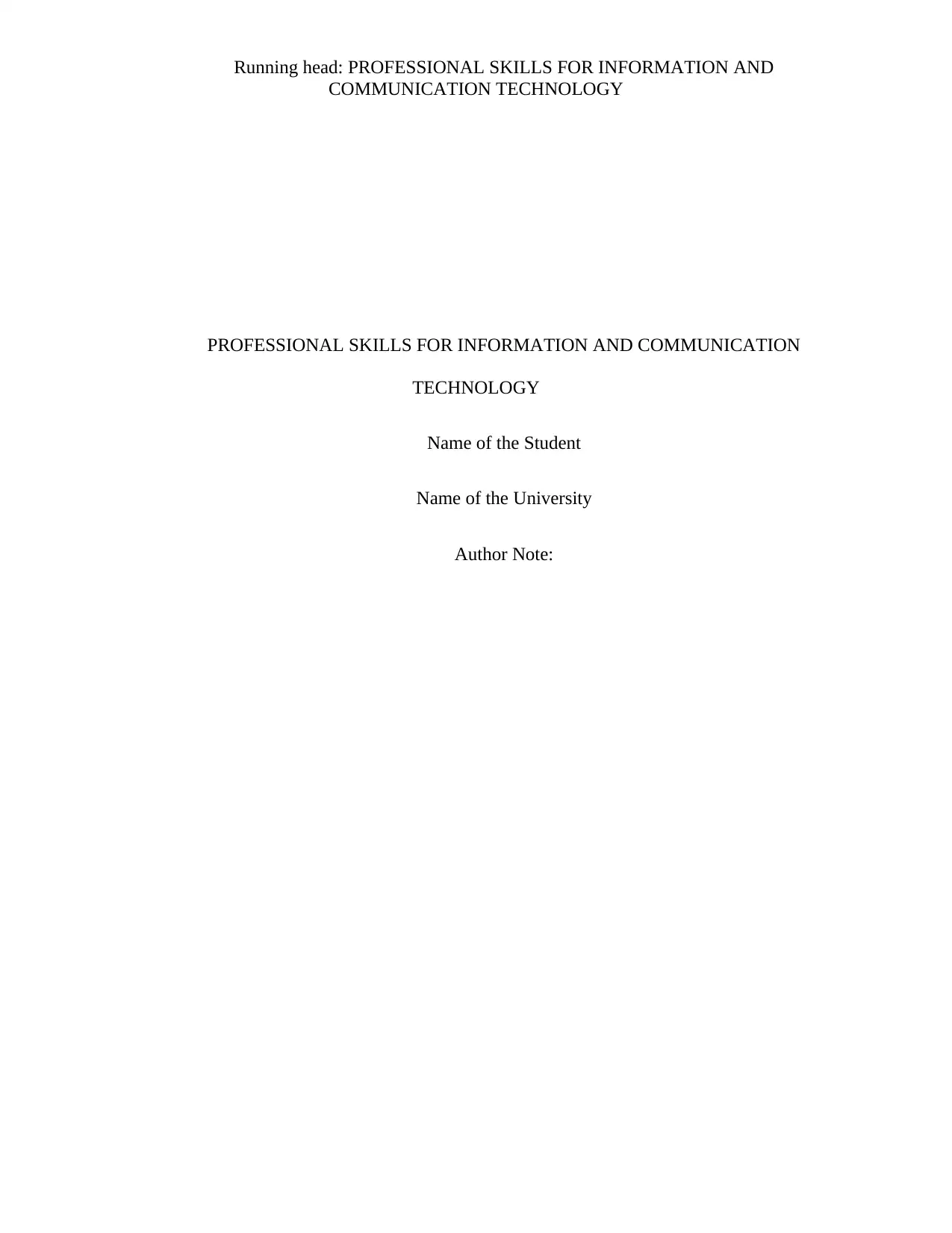
Running head: PROFESSIONAL SKILLS FOR INFORMATION AND
COMMUNICATION TECHNOLOGY
PROFESSIONAL SKILLS FOR INFORMATION AND COMMUNICATION
TECHNOLOGY
Name of the Student
Name of the University
Author Note:
COMMUNICATION TECHNOLOGY
PROFESSIONAL SKILLS FOR INFORMATION AND COMMUNICATION
TECHNOLOGY
Name of the Student
Name of the University
Author Note:
Paraphrase This Document
Need a fresh take? Get an instant paraphrase of this document with our AI Paraphraser
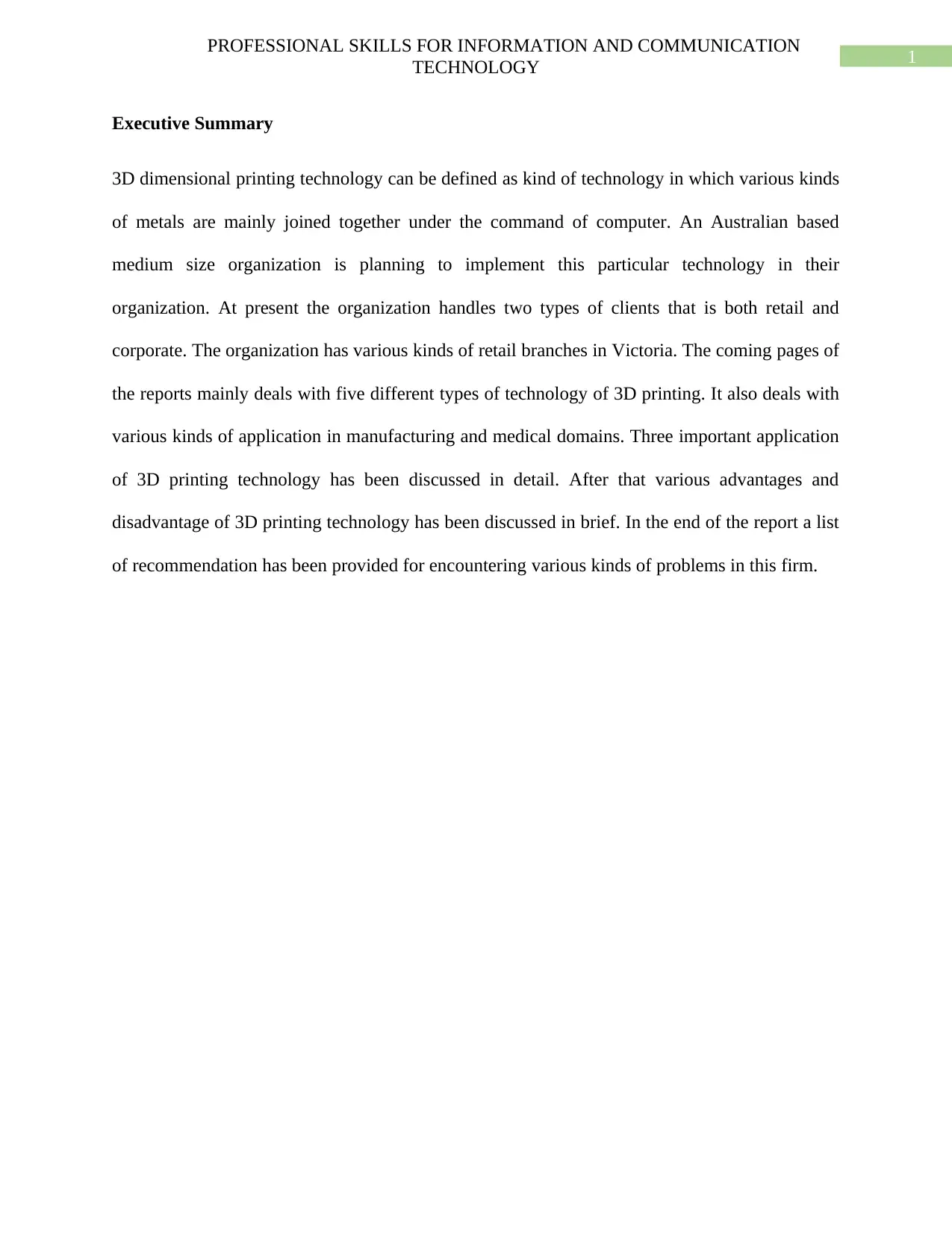
1
PROFESSIONAL SKILLS FOR INFORMATION AND COMMUNICATION
TECHNOLOGY
Executive Summary
3D dimensional printing technology can be defined as kind of technology in which various kinds
of metals are mainly joined together under the command of computer. An Australian based
medium size organization is planning to implement this particular technology in their
organization. At present the organization handles two types of clients that is both retail and
corporate. The organization has various kinds of retail branches in Victoria. The coming pages of
the reports mainly deals with five different types of technology of 3D printing. It also deals with
various kinds of application in manufacturing and medical domains. Three important application
of 3D printing technology has been discussed in detail. After that various advantages and
disadvantage of 3D printing technology has been discussed in brief. In the end of the report a list
of recommendation has been provided for encountering various kinds of problems in this firm.
PROFESSIONAL SKILLS FOR INFORMATION AND COMMUNICATION
TECHNOLOGY
Executive Summary
3D dimensional printing technology can be defined as kind of technology in which various kinds
of metals are mainly joined together under the command of computer. An Australian based
medium size organization is planning to implement this particular technology in their
organization. At present the organization handles two types of clients that is both retail and
corporate. The organization has various kinds of retail branches in Victoria. The coming pages of
the reports mainly deals with five different types of technology of 3D printing. It also deals with
various kinds of application in manufacturing and medical domains. Three important application
of 3D printing technology has been discussed in detail. After that various advantages and
disadvantage of 3D printing technology has been discussed in brief. In the end of the report a list
of recommendation has been provided for encountering various kinds of problems in this firm.
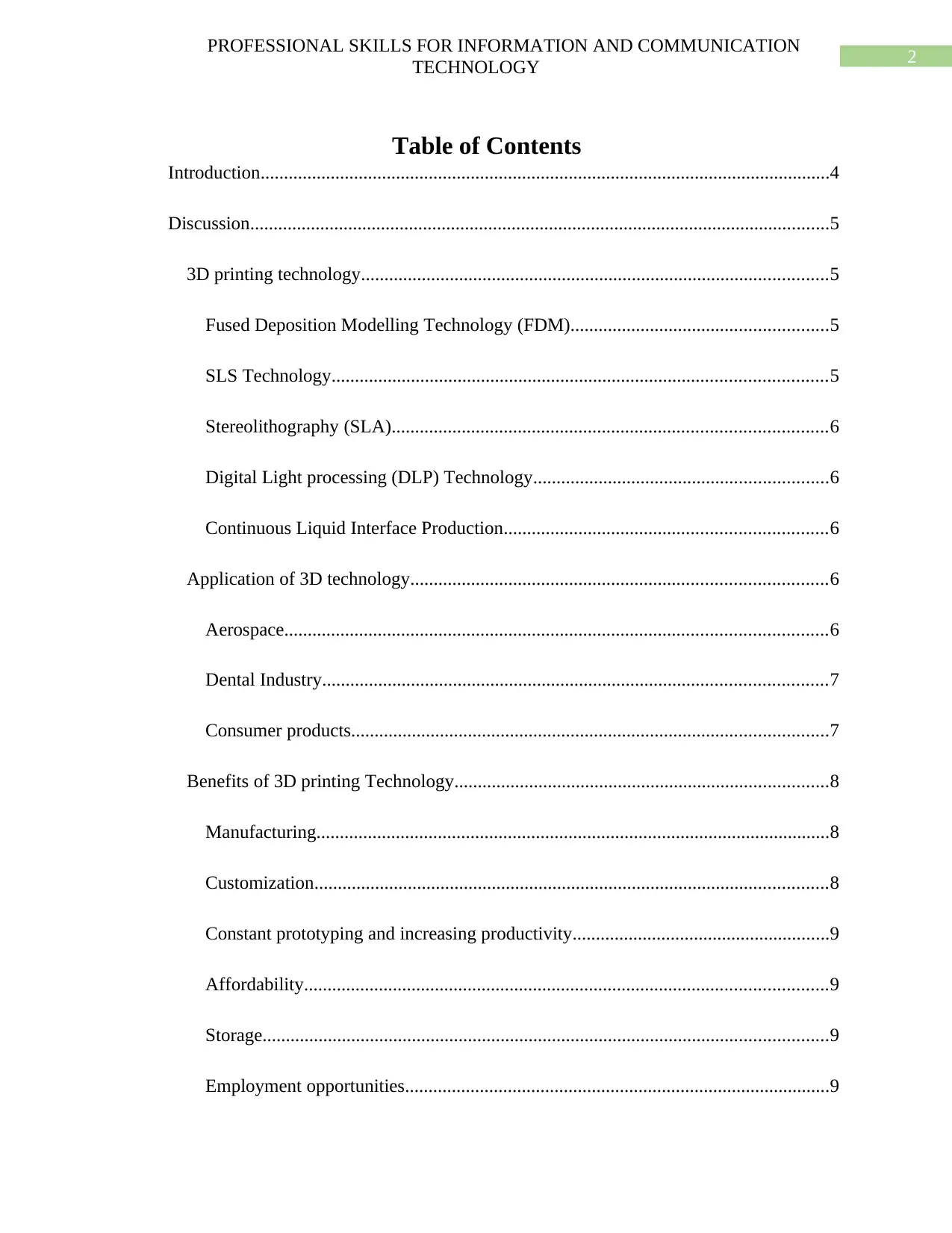
2
PROFESSIONAL SKILLS FOR INFORMATION AND COMMUNICATION
TECHNOLOGY
Table of Contents
Introduction..........................................................................................................................4
Discussion............................................................................................................................5
3D printing technology....................................................................................................5
Fused Deposition Modelling Technology (FDM).......................................................5
SLS Technology..........................................................................................................5
Stereolithography (SLA).............................................................................................6
Digital Light processing (DLP) Technology...............................................................6
Continuous Liquid Interface Production.....................................................................6
Application of 3D technology.........................................................................................6
Aerospace....................................................................................................................6
Dental Industry............................................................................................................7
Consumer products......................................................................................................7
Benefits of 3D printing Technology................................................................................8
Manufacturing..............................................................................................................8
Customization..............................................................................................................8
Constant prototyping and increasing productivity.......................................................9
Affordability................................................................................................................9
Storage.........................................................................................................................9
Employment opportunities...........................................................................................9
PROFESSIONAL SKILLS FOR INFORMATION AND COMMUNICATION
TECHNOLOGY
Table of Contents
Introduction..........................................................................................................................4
Discussion............................................................................................................................5
3D printing technology....................................................................................................5
Fused Deposition Modelling Technology (FDM).......................................................5
SLS Technology..........................................................................................................5
Stereolithography (SLA).............................................................................................6
Digital Light processing (DLP) Technology...............................................................6
Continuous Liquid Interface Production.....................................................................6
Application of 3D technology.........................................................................................6
Aerospace....................................................................................................................6
Dental Industry............................................................................................................7
Consumer products......................................................................................................7
Benefits of 3D printing Technology................................................................................8
Manufacturing..............................................................................................................8
Customization..............................................................................................................8
Constant prototyping and increasing productivity.......................................................9
Affordability................................................................................................................9
Storage.........................................................................................................................9
Employment opportunities...........................................................................................9
⊘ This is a preview!⊘
Do you want full access?
Subscribe today to unlock all pages.

Trusted by 1+ million students worldwide
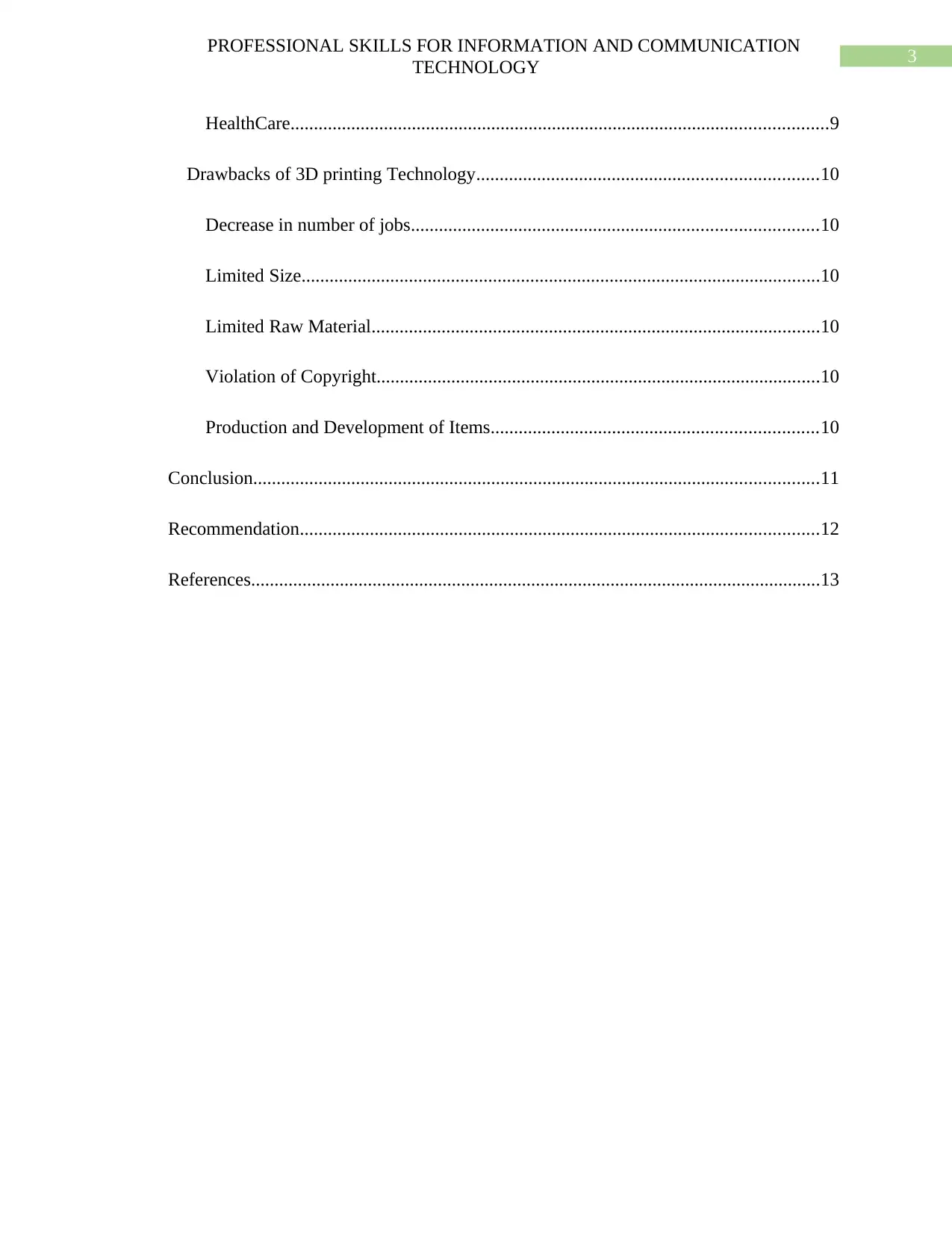
3
PROFESSIONAL SKILLS FOR INFORMATION AND COMMUNICATION
TECHNOLOGY
HealthCare...................................................................................................................9
Drawbacks of 3D printing Technology.........................................................................10
Decrease in number of jobs.......................................................................................10
Limited Size...............................................................................................................10
Limited Raw Material................................................................................................10
Violation of Copyright...............................................................................................10
Production and Development of Items......................................................................10
Conclusion.........................................................................................................................11
Recommendation...............................................................................................................12
References..........................................................................................................................13
PROFESSIONAL SKILLS FOR INFORMATION AND COMMUNICATION
TECHNOLOGY
HealthCare...................................................................................................................9
Drawbacks of 3D printing Technology.........................................................................10
Decrease in number of jobs.......................................................................................10
Limited Size...............................................................................................................10
Limited Raw Material................................................................................................10
Violation of Copyright...............................................................................................10
Production and Development of Items......................................................................10
Conclusion.........................................................................................................................11
Recommendation...............................................................................................................12
References..........................................................................................................................13
Paraphrase This Document
Need a fresh take? Get an instant paraphrase of this document with our AI Paraphraser
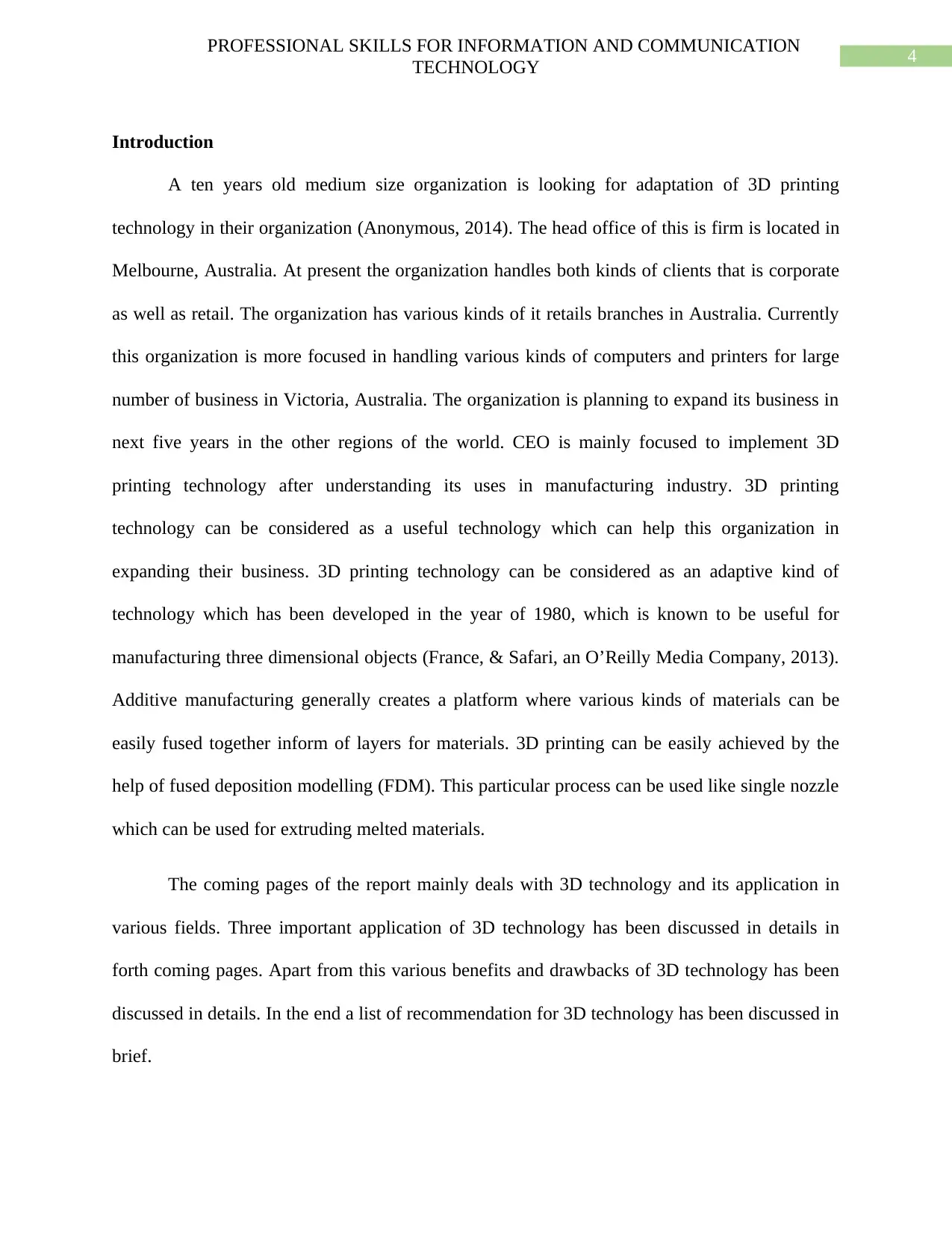
4
PROFESSIONAL SKILLS FOR INFORMATION AND COMMUNICATION
TECHNOLOGY
Introduction
A ten years old medium size organization is looking for adaptation of 3D printing
technology in their organization (Anonymous, 2014). The head office of this is firm is located in
Melbourne, Australia. At present the organization handles both kinds of clients that is corporate
as well as retail. The organization has various kinds of it retails branches in Australia. Currently
this organization is more focused in handling various kinds of computers and printers for large
number of business in Victoria, Australia. The organization is planning to expand its business in
next five years in the other regions of the world. CEO is mainly focused to implement 3D
printing technology after understanding its uses in manufacturing industry. 3D printing
technology can be considered as a useful technology which can help this organization in
expanding their business. 3D printing technology can be considered as an adaptive kind of
technology which has been developed in the year of 1980, which is known to be useful for
manufacturing three dimensional objects (France, & Safari, an O’Reilly Media Company, 2013).
Additive manufacturing generally creates a platform where various kinds of materials can be
easily fused together inform of layers for materials. 3D printing can be easily achieved by the
help of fused deposition modelling (FDM). This particular process can be used like single nozzle
which can be used for extruding melted materials.
The coming pages of the report mainly deals with 3D technology and its application in
various fields. Three important application of 3D technology has been discussed in details in
forth coming pages. Apart from this various benefits and drawbacks of 3D technology has been
discussed in details. In the end a list of recommendation for 3D technology has been discussed in
brief.
PROFESSIONAL SKILLS FOR INFORMATION AND COMMUNICATION
TECHNOLOGY
Introduction
A ten years old medium size organization is looking for adaptation of 3D printing
technology in their organization (Anonymous, 2014). The head office of this is firm is located in
Melbourne, Australia. At present the organization handles both kinds of clients that is corporate
as well as retail. The organization has various kinds of it retails branches in Australia. Currently
this organization is more focused in handling various kinds of computers and printers for large
number of business in Victoria, Australia. The organization is planning to expand its business in
next five years in the other regions of the world. CEO is mainly focused to implement 3D
printing technology after understanding its uses in manufacturing industry. 3D printing
technology can be considered as a useful technology which can help this organization in
expanding their business. 3D printing technology can be considered as an adaptive kind of
technology which has been developed in the year of 1980, which is known to be useful for
manufacturing three dimensional objects (France, & Safari, an O’Reilly Media Company, 2013).
Additive manufacturing generally creates a platform where various kinds of materials can be
easily fused together inform of layers for materials. 3D printing can be easily achieved by the
help of fused deposition modelling (FDM). This particular process can be used like single nozzle
which can be used for extruding melted materials.
The coming pages of the report mainly deals with 3D technology and its application in
various fields. Three important application of 3D technology has been discussed in details in
forth coming pages. Apart from this various benefits and drawbacks of 3D technology has been
discussed in details. In the end a list of recommendation for 3D technology has been discussed in
brief.
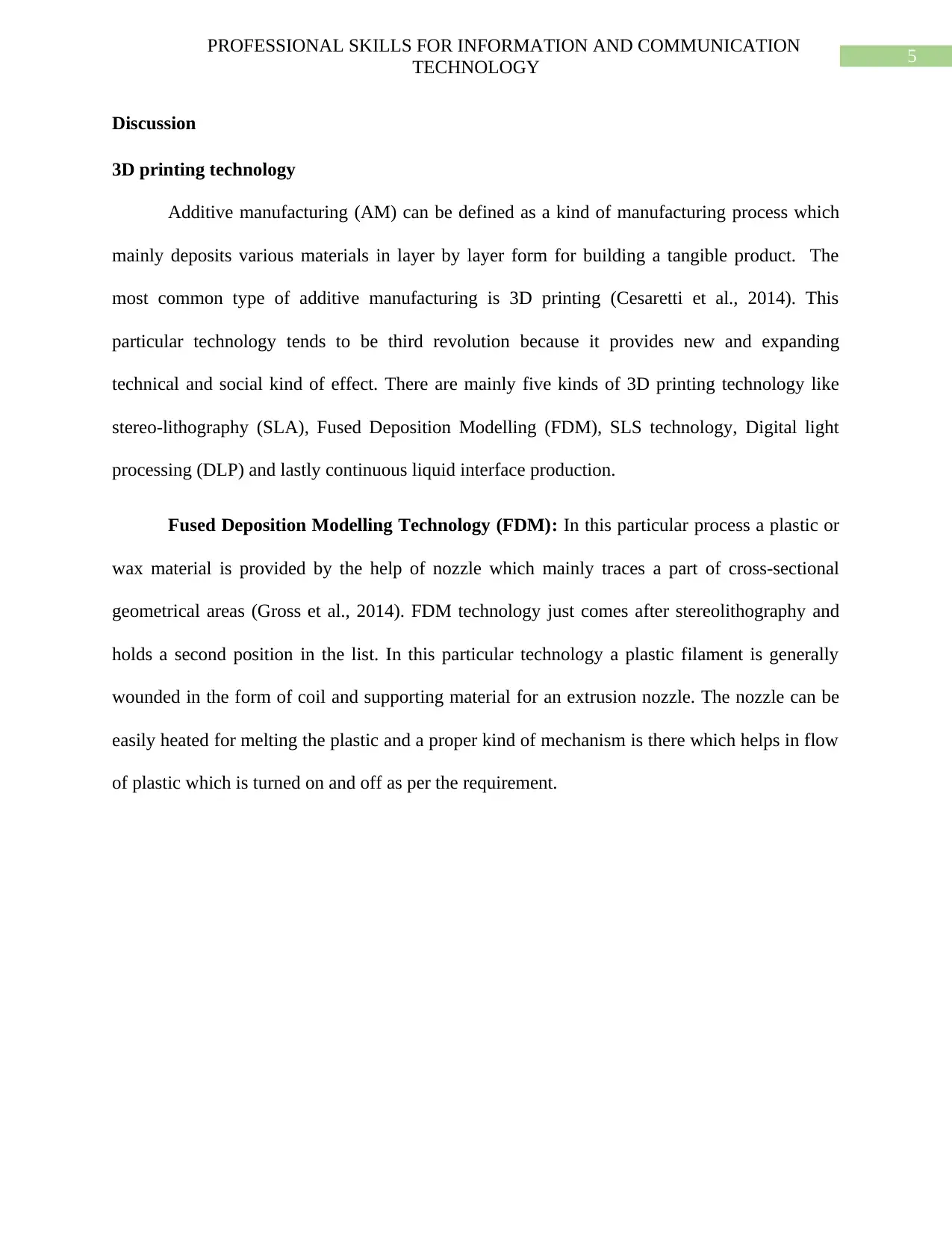
5
PROFESSIONAL SKILLS FOR INFORMATION AND COMMUNICATION
TECHNOLOGY
Discussion
3D printing technology
Additive manufacturing (AM) can be defined as a kind of manufacturing process which
mainly deposits various materials in layer by layer form for building a tangible product. The
most common type of additive manufacturing is 3D printing (Cesaretti et al., 2014). This
particular technology tends to be third revolution because it provides new and expanding
technical and social kind of effect. There are mainly five kinds of 3D printing technology like
stereo-lithography (SLA), Fused Deposition Modelling (FDM), SLS technology, Digital light
processing (DLP) and lastly continuous liquid interface production.
Fused Deposition Modelling Technology (FDM): In this particular process a plastic or
wax material is provided by the help of nozzle which mainly traces a part of cross-sectional
geometrical areas (Gross et al., 2014). FDM technology just comes after stereolithography and
holds a second position in the list. In this particular technology a plastic filament is generally
wounded in the form of coil and supporting material for an extrusion nozzle. The nozzle can be
easily heated for melting the plastic and a proper kind of mechanism is there which helps in flow
of plastic which is turned on and off as per the requirement.
PROFESSIONAL SKILLS FOR INFORMATION AND COMMUNICATION
TECHNOLOGY
Discussion
3D printing technology
Additive manufacturing (AM) can be defined as a kind of manufacturing process which
mainly deposits various materials in layer by layer form for building a tangible product. The
most common type of additive manufacturing is 3D printing (Cesaretti et al., 2014). This
particular technology tends to be third revolution because it provides new and expanding
technical and social kind of effect. There are mainly five kinds of 3D printing technology like
stereo-lithography (SLA), Fused Deposition Modelling (FDM), SLS technology, Digital light
processing (DLP) and lastly continuous liquid interface production.
Fused Deposition Modelling Technology (FDM): In this particular process a plastic or
wax material is provided by the help of nozzle which mainly traces a part of cross-sectional
geometrical areas (Gross et al., 2014). FDM technology just comes after stereolithography and
holds a second position in the list. In this particular technology a plastic filament is generally
wounded in the form of coil and supporting material for an extrusion nozzle. The nozzle can be
easily heated for melting the plastic and a proper kind of mechanism is there which helps in flow
of plastic which is turned on and off as per the requirement.
⊘ This is a preview!⊘
Do you want full access?
Subscribe today to unlock all pages.

Trusted by 1+ million students worldwide
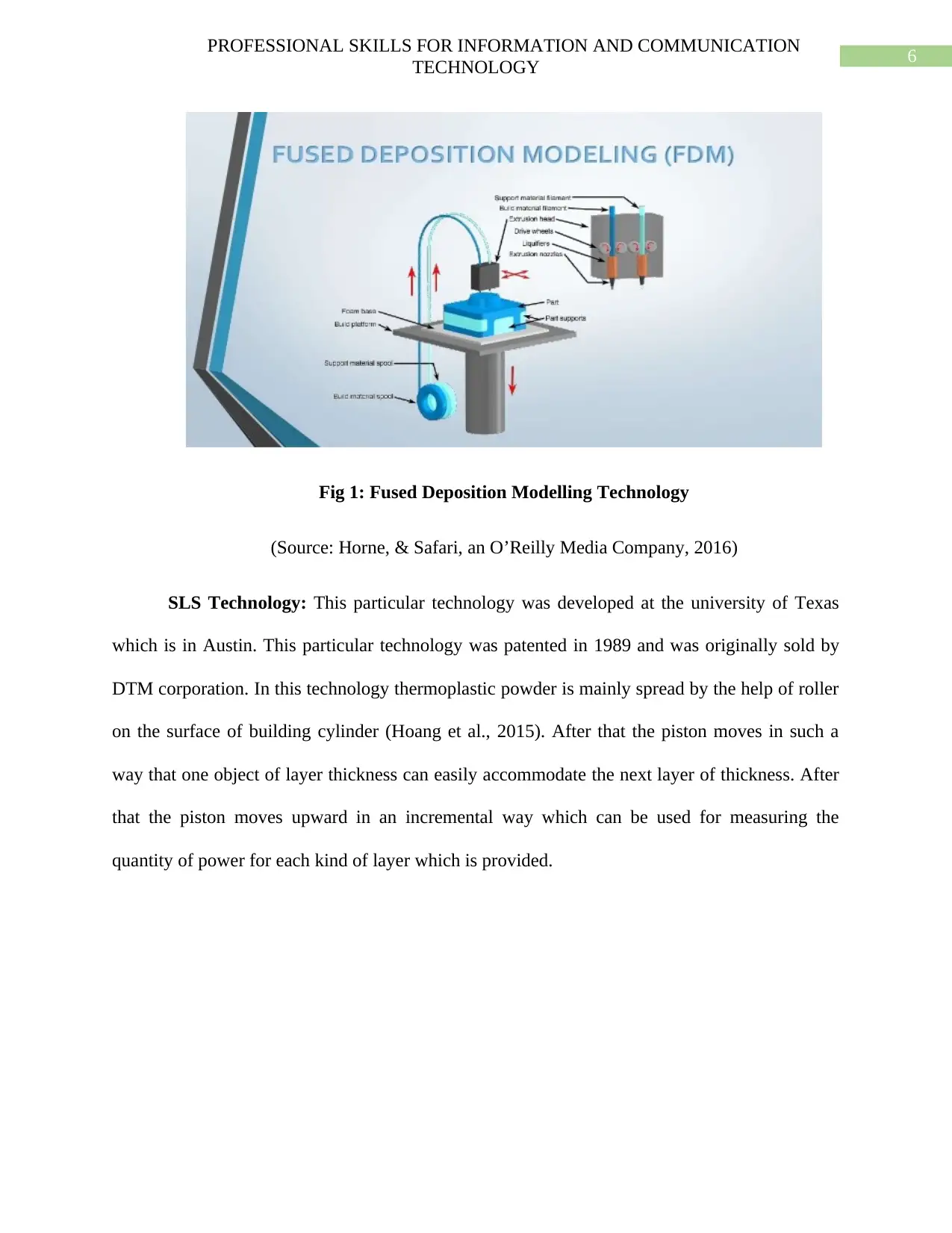
6
PROFESSIONAL SKILLS FOR INFORMATION AND COMMUNICATION
TECHNOLOGY
Fig 1: Fused Deposition Modelling Technology
(Source: Horne, & Safari, an O’Reilly Media Company, 2016)
SLS Technology: This particular technology was developed at the university of Texas
which is in Austin. This particular technology was patented in 1989 and was originally sold by
DTM corporation. In this technology thermoplastic powder is mainly spread by the help of roller
on the surface of building cylinder (Hoang et al., 2015). After that the piston moves in such a
way that one object of layer thickness can easily accommodate the next layer of thickness. After
that the piston moves upward in an incremental way which can be used for measuring the
quantity of power for each kind of layer which is provided.
PROFESSIONAL SKILLS FOR INFORMATION AND COMMUNICATION
TECHNOLOGY
Fig 1: Fused Deposition Modelling Technology
(Source: Horne, & Safari, an O’Reilly Media Company, 2016)
SLS Technology: This particular technology was developed at the university of Texas
which is in Austin. This particular technology was patented in 1989 and was originally sold by
DTM corporation. In this technology thermoplastic powder is mainly spread by the help of roller
on the surface of building cylinder (Hoang et al., 2015). After that the piston moves in such a
way that one object of layer thickness can easily accommodate the next layer of thickness. After
that the piston moves upward in an incremental way which can be used for measuring the
quantity of power for each kind of layer which is provided.
Paraphrase This Document
Need a fresh take? Get an instant paraphrase of this document with our AI Paraphraser
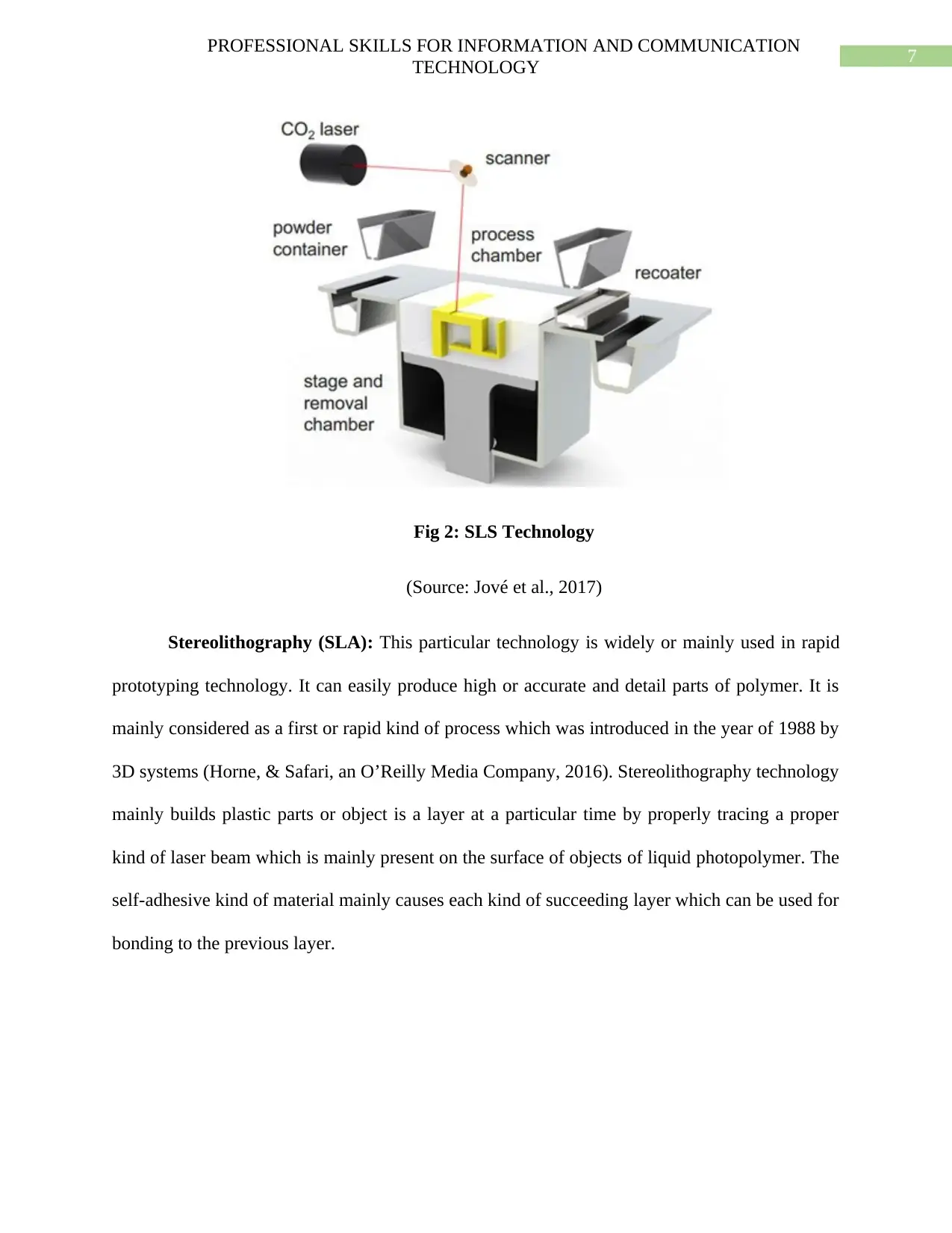
7
PROFESSIONAL SKILLS FOR INFORMATION AND COMMUNICATION
TECHNOLOGY
Fig 2: SLS Technology
(Source: Jové et al., 2017)
Stereolithography (SLA): This particular technology is widely or mainly used in rapid
prototyping technology. It can easily produce high or accurate and detail parts of polymer. It is
mainly considered as a first or rapid kind of process which was introduced in the year of 1988 by
3D systems (Horne, & Safari, an O’Reilly Media Company, 2016). Stereolithography technology
mainly builds plastic parts or object is a layer at a particular time by properly tracing a proper
kind of laser beam which is mainly present on the surface of objects of liquid photopolymer. The
self-adhesive kind of material mainly causes each kind of succeeding layer which can be used for
bonding to the previous layer.
PROFESSIONAL SKILLS FOR INFORMATION AND COMMUNICATION
TECHNOLOGY
Fig 2: SLS Technology
(Source: Jové et al., 2017)
Stereolithography (SLA): This particular technology is widely or mainly used in rapid
prototyping technology. It can easily produce high or accurate and detail parts of polymer. It is
mainly considered as a first or rapid kind of process which was introduced in the year of 1988 by
3D systems (Horne, & Safari, an O’Reilly Media Company, 2016). Stereolithography technology
mainly builds plastic parts or object is a layer at a particular time by properly tracing a proper
kind of laser beam which is mainly present on the surface of objects of liquid photopolymer. The
self-adhesive kind of material mainly causes each kind of succeeding layer which can be used for
bonding to the previous layer.
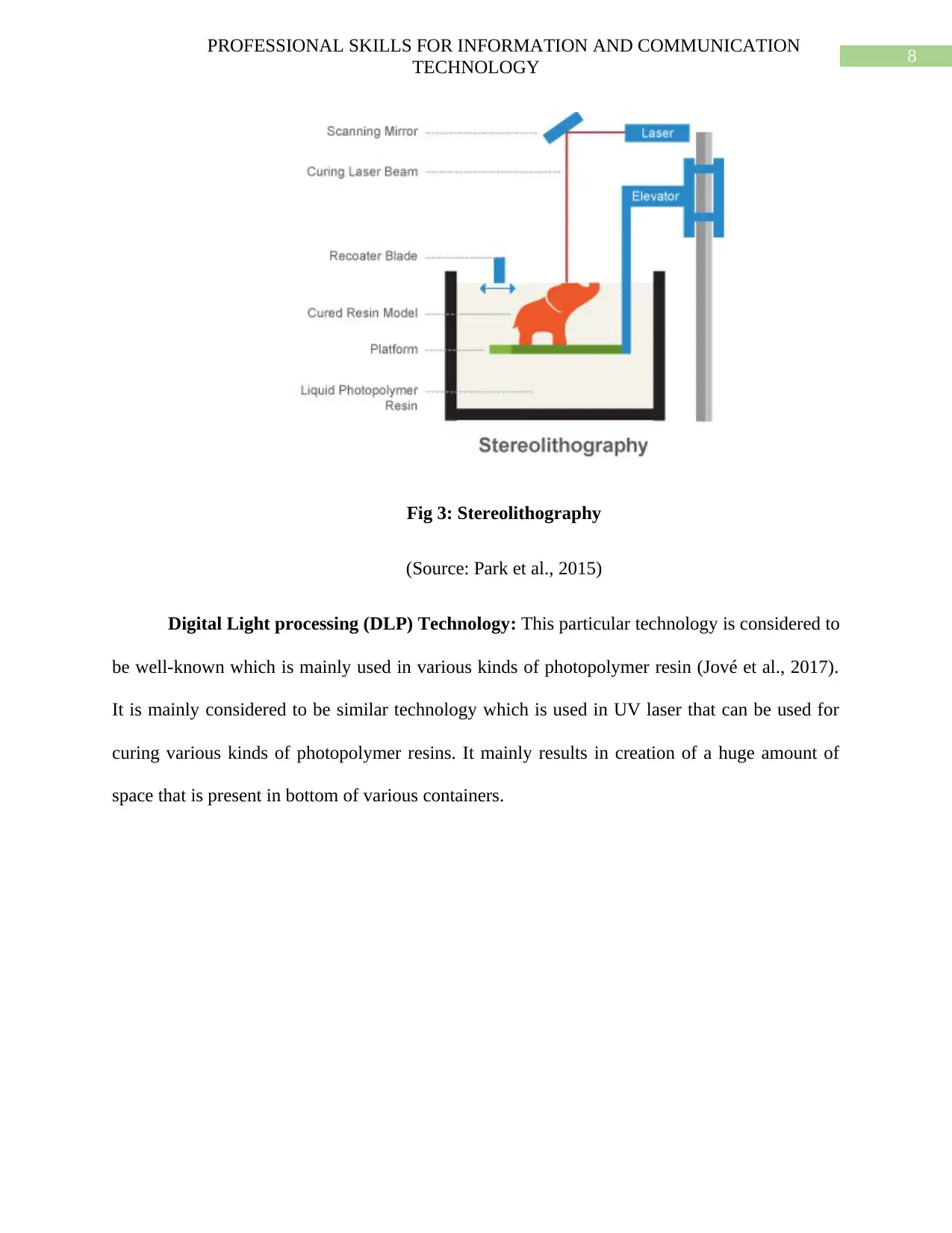
8
PROFESSIONAL SKILLS FOR INFORMATION AND COMMUNICATION
TECHNOLOGY
Fig 3: Stereolithography
(Source: Park et al., 2015)
Digital Light processing (DLP) Technology: This particular technology is considered to
be well-known which is mainly used in various kinds of photopolymer resin (Jové et al., 2017).
It is mainly considered to be similar technology which is used in UV laser that can be used for
curing various kinds of photopolymer resins. It mainly results in creation of a huge amount of
space that is present in bottom of various containers.
PROFESSIONAL SKILLS FOR INFORMATION AND COMMUNICATION
TECHNOLOGY
Fig 3: Stereolithography
(Source: Park et al., 2015)
Digital Light processing (DLP) Technology: This particular technology is considered to
be well-known which is mainly used in various kinds of photopolymer resin (Jové et al., 2017).
It is mainly considered to be similar technology which is used in UV laser that can be used for
curing various kinds of photopolymer resins. It mainly results in creation of a huge amount of
space that is present in bottom of various containers.
⊘ This is a preview!⊘
Do you want full access?
Subscribe today to unlock all pages.

Trusted by 1+ million students worldwide
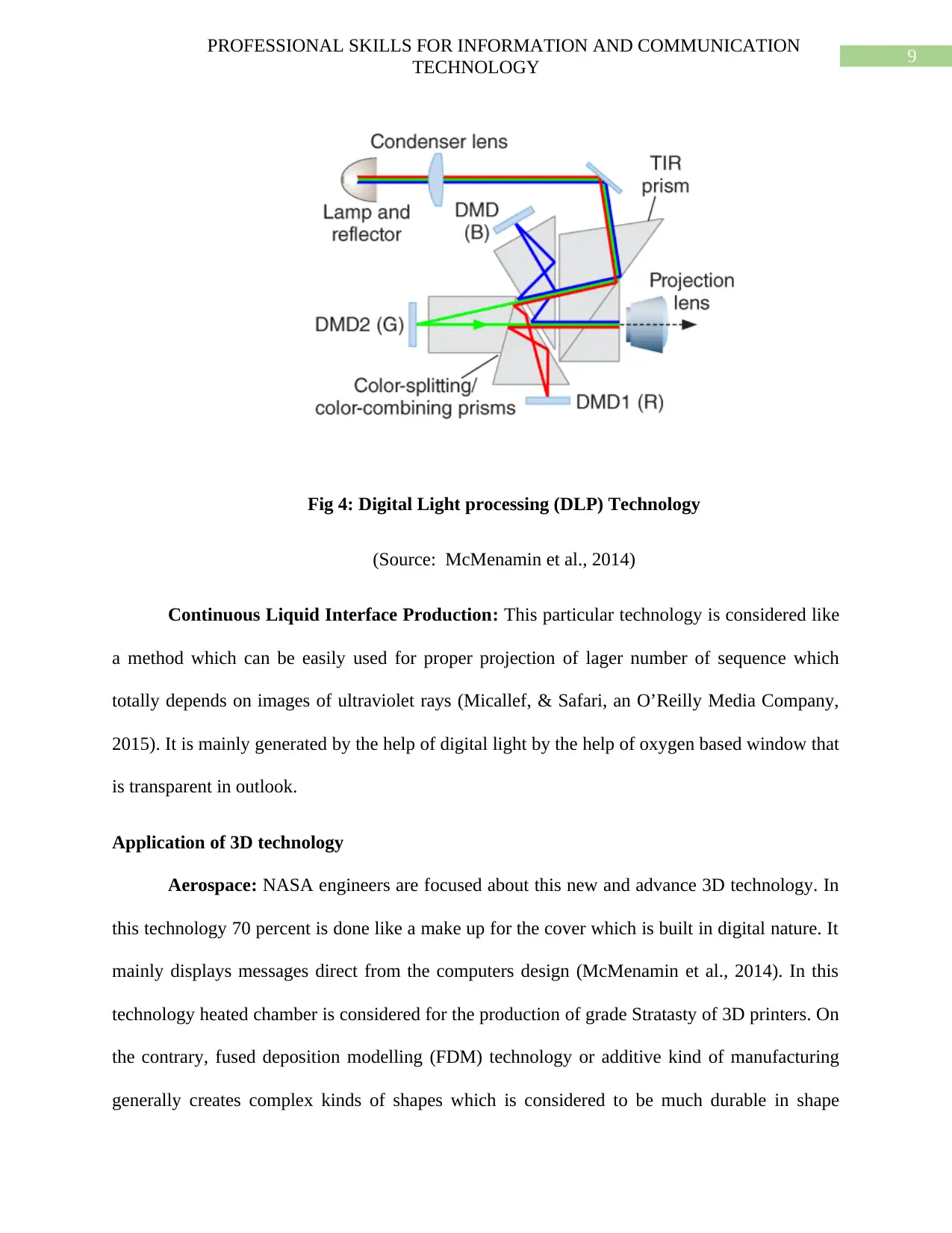
9
PROFESSIONAL SKILLS FOR INFORMATION AND COMMUNICATION
TECHNOLOGY
Fig 4: Digital Light processing (DLP) Technology
(Source: McMenamin et al., 2014)
Continuous Liquid Interface Production: This particular technology is considered like
a method which can be easily used for proper projection of lager number of sequence which
totally depends on images of ultraviolet rays (Micallef, & Safari, an O’Reilly Media Company,
2015). It is mainly generated by the help of digital light by the help of oxygen based window that
is transparent in outlook.
Application of 3D technology
Aerospace: NASA engineers are focused about this new and advance 3D technology. In
this technology 70 percent is done like a make up for the cover which is built in digital nature. It
mainly displays messages direct from the computers design (McMenamin et al., 2014). In this
technology heated chamber is considered for the production of grade Stratasty of 3D printers. On
the contrary, fused deposition modelling (FDM) technology or additive kind of manufacturing
generally creates complex kinds of shapes which is considered to be much durable in shape
PROFESSIONAL SKILLS FOR INFORMATION AND COMMUNICATION
TECHNOLOGY
Fig 4: Digital Light processing (DLP) Technology
(Source: McMenamin et al., 2014)
Continuous Liquid Interface Production: This particular technology is considered like
a method which can be easily used for proper projection of lager number of sequence which
totally depends on images of ultraviolet rays (Micallef, & Safari, an O’Reilly Media Company,
2015). It is mainly generated by the help of digital light by the help of oxygen based window that
is transparent in outlook.
Application of 3D technology
Aerospace: NASA engineers are focused about this new and advance 3D technology. In
this technology 70 percent is done like a make up for the cover which is built in digital nature. It
mainly displays messages direct from the computers design (McMenamin et al., 2014). In this
technology heated chamber is considered for the production of grade Stratasty of 3D printers. On
the contrary, fused deposition modelling (FDM) technology or additive kind of manufacturing
generally creates complex kinds of shapes which is considered to be much durable in shape
Paraphrase This Document
Need a fresh take? Get an instant paraphrase of this document with our AI Paraphraser
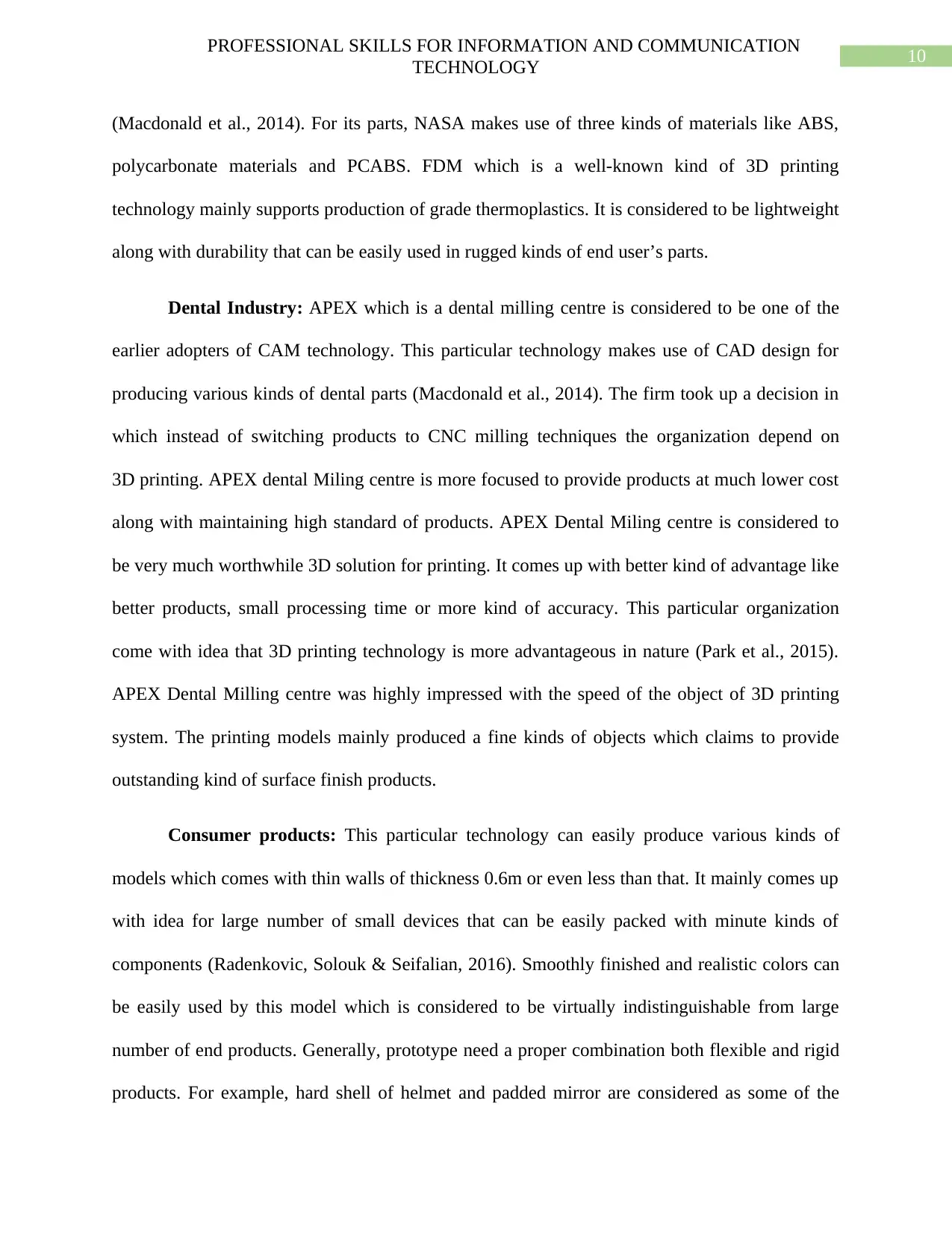
10
PROFESSIONAL SKILLS FOR INFORMATION AND COMMUNICATION
TECHNOLOGY
(Macdonald et al., 2014). For its parts, NASA makes use of three kinds of materials like ABS,
polycarbonate materials and PCABS. FDM which is a well-known kind of 3D printing
technology mainly supports production of grade thermoplastics. It is considered to be lightweight
along with durability that can be easily used in rugged kinds of end user’s parts.
Dental Industry: APEX which is a dental milling centre is considered to be one of the
earlier adopters of CAM technology. This particular technology makes use of CAD design for
producing various kinds of dental parts (Macdonald et al., 2014). The firm took up a decision in
which instead of switching products to CNC milling techniques the organization depend on
3D printing. APEX dental Miling centre is more focused to provide products at much lower cost
along with maintaining high standard of products. APEX Dental Miling centre is considered to
be very much worthwhile 3D solution for printing. It comes up with better kind of advantage like
better products, small processing time or more kind of accuracy. This particular organization
come with idea that 3D printing technology is more advantageous in nature (Park et al., 2015).
APEX Dental Milling centre was highly impressed with the speed of the object of 3D printing
system. The printing models mainly produced a fine kinds of objects which claims to provide
outstanding kind of surface finish products.
Consumer products: This particular technology can easily produce various kinds of
models which comes with thin walls of thickness 0.6m or even less than that. It mainly comes up
with idea for large number of small devices that can be easily packed with minute kinds of
components (Radenkovic, Solouk & Seifalian, 2016). Smoothly finished and realistic colors can
be easily used by this model which is considered to be virtually indistinguishable from large
number of end products. Generally, prototype need a proper combination both flexible and rigid
products. For example, hard shell of helmet and padded mirror are considered as some of the
PROFESSIONAL SKILLS FOR INFORMATION AND COMMUNICATION
TECHNOLOGY
(Macdonald et al., 2014). For its parts, NASA makes use of three kinds of materials like ABS,
polycarbonate materials and PCABS. FDM which is a well-known kind of 3D printing
technology mainly supports production of grade thermoplastics. It is considered to be lightweight
along with durability that can be easily used in rugged kinds of end user’s parts.
Dental Industry: APEX which is a dental milling centre is considered to be one of the
earlier adopters of CAM technology. This particular technology makes use of CAD design for
producing various kinds of dental parts (Macdonald et al., 2014). The firm took up a decision in
which instead of switching products to CNC milling techniques the organization depend on
3D printing. APEX dental Miling centre is more focused to provide products at much lower cost
along with maintaining high standard of products. APEX Dental Miling centre is considered to
be very much worthwhile 3D solution for printing. It comes up with better kind of advantage like
better products, small processing time or more kind of accuracy. This particular organization
come with idea that 3D printing technology is more advantageous in nature (Park et al., 2015).
APEX Dental Milling centre was highly impressed with the speed of the object of 3D printing
system. The printing models mainly produced a fine kinds of objects which claims to provide
outstanding kind of surface finish products.
Consumer products: This particular technology can easily produce various kinds of
models which comes with thin walls of thickness 0.6m or even less than that. It mainly comes up
with idea for large number of small devices that can be easily packed with minute kinds of
components (Radenkovic, Solouk & Seifalian, 2016). Smoothly finished and realistic colors can
be easily used by this model which is considered to be virtually indistinguishable from large
number of end products. Generally, prototype need a proper combination both flexible and rigid
products. For example, hard shell of helmet and padded mirror are considered as some of the
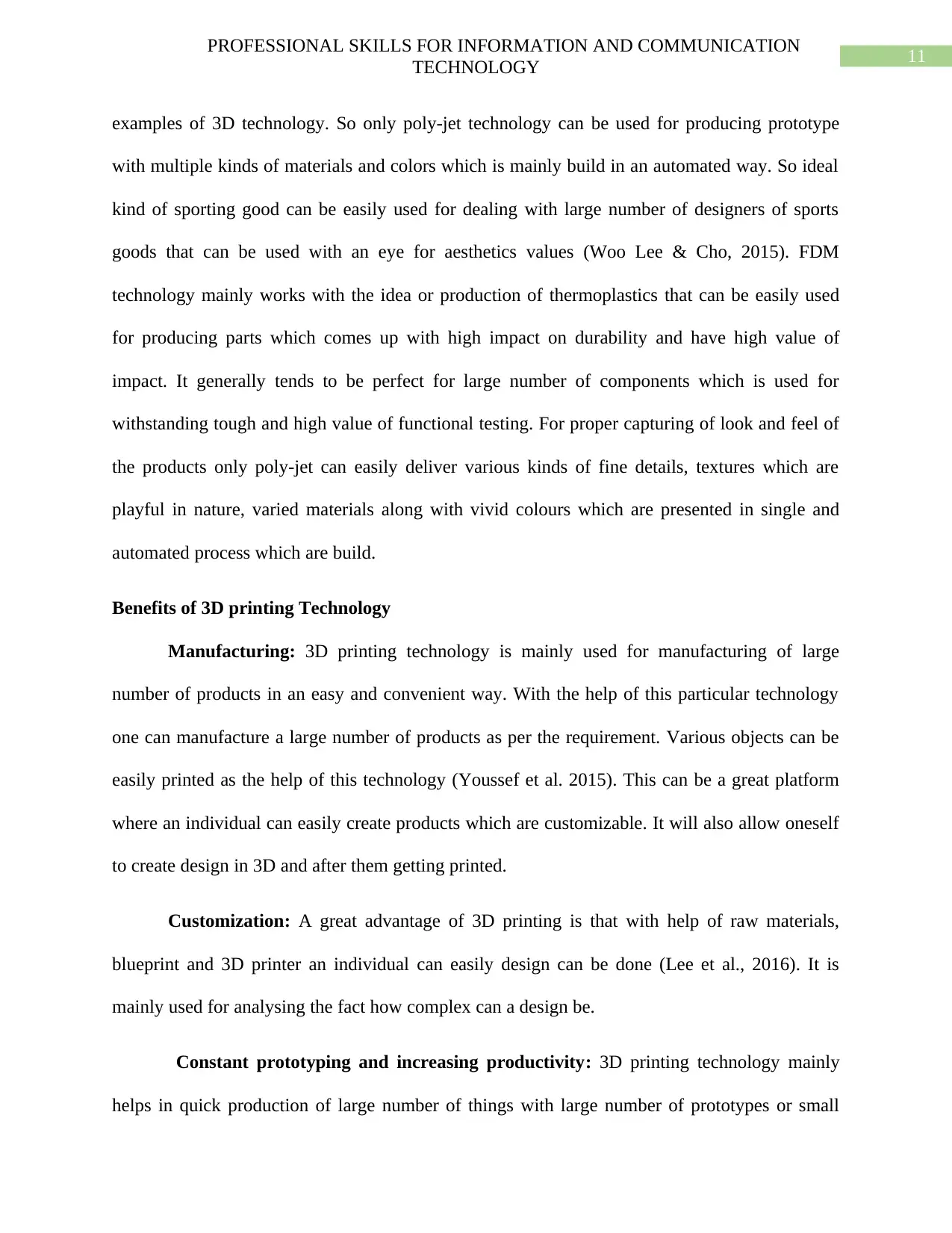
11
PROFESSIONAL SKILLS FOR INFORMATION AND COMMUNICATION
TECHNOLOGY
examples of 3D technology. So only poly-jet technology can be used for producing prototype
with multiple kinds of materials and colors which is mainly build in an automated way. So ideal
kind of sporting good can be easily used for dealing with large number of designers of sports
goods that can be used with an eye for aesthetics values (Woo Lee & Cho, 2015). FDM
technology mainly works with the idea or production of thermoplastics that can be easily used
for producing parts which comes up with high impact on durability and have high value of
impact. It generally tends to be perfect for large number of components which is used for
withstanding tough and high value of functional testing. For proper capturing of look and feel of
the products only poly-jet can easily deliver various kinds of fine details, textures which are
playful in nature, varied materials along with vivid colours which are presented in single and
automated process which are build.
Benefits of 3D printing Technology
Manufacturing: 3D printing technology is mainly used for manufacturing of large
number of products in an easy and convenient way. With the help of this particular technology
one can manufacture a large number of products as per the requirement. Various objects can be
easily printed as the help of this technology (Youssef et al. 2015). This can be a great platform
where an individual can easily create products which are customizable. It will also allow oneself
to create design in 3D and after them getting printed.
Customization: A great advantage of 3D printing is that with help of raw materials,
blueprint and 3D printer an individual can easily design can be done (Lee et al., 2016). It is
mainly used for analysing the fact how complex can a design be.
Constant prototyping and increasing productivity: 3D printing technology mainly
helps in quick production of large number of things with large number of prototypes or small
PROFESSIONAL SKILLS FOR INFORMATION AND COMMUNICATION
TECHNOLOGY
examples of 3D technology. So only poly-jet technology can be used for producing prototype
with multiple kinds of materials and colors which is mainly build in an automated way. So ideal
kind of sporting good can be easily used for dealing with large number of designers of sports
goods that can be used with an eye for aesthetics values (Woo Lee & Cho, 2015). FDM
technology mainly works with the idea or production of thermoplastics that can be easily used
for producing parts which comes up with high impact on durability and have high value of
impact. It generally tends to be perfect for large number of components which is used for
withstanding tough and high value of functional testing. For proper capturing of look and feel of
the products only poly-jet can easily deliver various kinds of fine details, textures which are
playful in nature, varied materials along with vivid colours which are presented in single and
automated process which are build.
Benefits of 3D printing Technology
Manufacturing: 3D printing technology is mainly used for manufacturing of large
number of products in an easy and convenient way. With the help of this particular technology
one can manufacture a large number of products as per the requirement. Various objects can be
easily printed as the help of this technology (Youssef et al. 2015). This can be a great platform
where an individual can easily create products which are customizable. It will also allow oneself
to create design in 3D and after them getting printed.
Customization: A great advantage of 3D printing is that with help of raw materials,
blueprint and 3D printer an individual can easily design can be done (Lee et al., 2016). It is
mainly used for analysing the fact how complex can a design be.
Constant prototyping and increasing productivity: 3D printing technology mainly
helps in quick production of large number of things with large number of prototypes or small
⊘ This is a preview!⊘
Do you want full access?
Subscribe today to unlock all pages.

Trusted by 1+ million students worldwide
1 out of 19
Related Documents
Your All-in-One AI-Powered Toolkit for Academic Success.
+13062052269
info@desklib.com
Available 24*7 on WhatsApp / Email
![[object Object]](/_next/static/media/star-bottom.7253800d.svg)
Unlock your academic potential
Copyright © 2020–2025 A2Z Services. All Rights Reserved. Developed and managed by ZUCOL.





